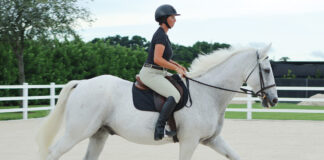
Q: My horse has a tendency to completely ignore me at the canter. He shoves his head out and forward, opens his mouth to evade the bit, and runs off. Usually I’m heading to a jump when he gets completely unresponsive; I have no control over his stride. He’s not normally a horse that gets excited. I ride on a looser rein and use a simple D-ring snaffle and plain noseband. I’ve tried stopping things so I can restart, and usually he will finally respond, but it only lasts for the day. Can you help me?
On the flat is where you’ll need to do most of your homework. Flatwork is the most important part of your riding routine, as it sets the stage for an effective jump school. Transitions, both upward and downward, are key elements in your flatwork. When done correctly, transitions not only teach your horse to pay attention, they also build his hind end strength. A horse should be asked to gather himself through a transition; he shouldn’t lunge into a faster gait or fall into a heap on his forehand when slowing down. When done in balance, transitions will help your horse get lighter on his front end and softer in his mouth, which will help keep him from getting heavy in your hands and running away with you.
You mention that you ride with longer reins, and this may be a part of the problem. Riding with short enough reins helps put you in the correct position over the middle of your horse. If you ride with a longer rein, you can accidentally put yourself behind the motion and create a driving seat, which will send the horse more forward.
Although you may not think you’re getting anxious as you approach a fence, your horse may sense otherwise. Setting up rails on the ground and focusing on your flatwork and rhythm as you ride over them can help make jumping seem like no big deal. Start by going over a single rail on a circle, and then add in straighter lines and more rails. Keeping a consistent pace is key, as is your breathing.
Exhaling before you go over the pole will relax your body and make sure you’re not transmitting tension to your horse. Try to not worry about a distance to the pole; think more about keeping an even pace and focus on your breathing. Keep these same ideas in mind when you start going over jumps. Be very aware of your own energy as you come to your fence and try not to anticipate your horse getting stronger or faster. It can also be helpful to add some jumps into your flatwork as you’re cantering around, reinforcing to your horse that jumping should be a non-issue.
Sometimes when you stop jumping and then begin again, you and your horse both have time to get a little anxious and excited. If your horse gets too strong over fences, go back to flatwork and transitions, or even to rails on the ground. But don’t stop and let him stand, then immediately approach the fence again.
Lastly, don’t be afraid to try some different bits; it’s worth experimenting to see if he’s more willing and comfortable in a different bit.
STEPHANIE “STEVIE” McCARRON worked with industry greats such as Karen Healy, Barbara Ellison and Anne Kursinski before settling in Midway, Ky., at her own Cloud Nine Farm, where she specializes in hunters and jumpers.
This article originally appeared in the April 2015 issue of Horse Illustrated magazine. Click here to subscribe!






